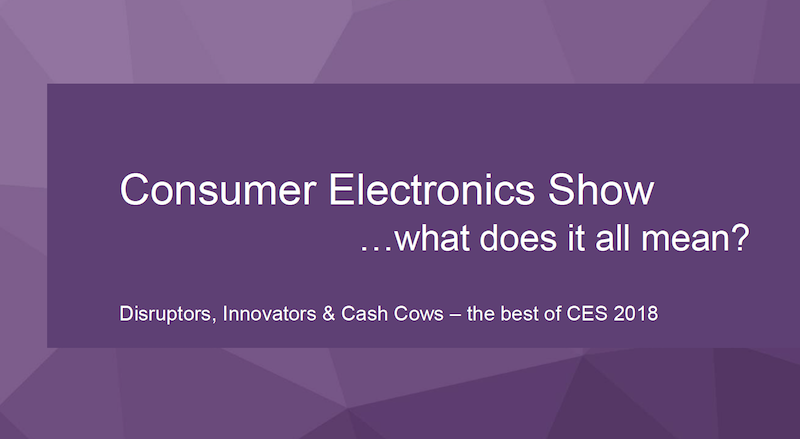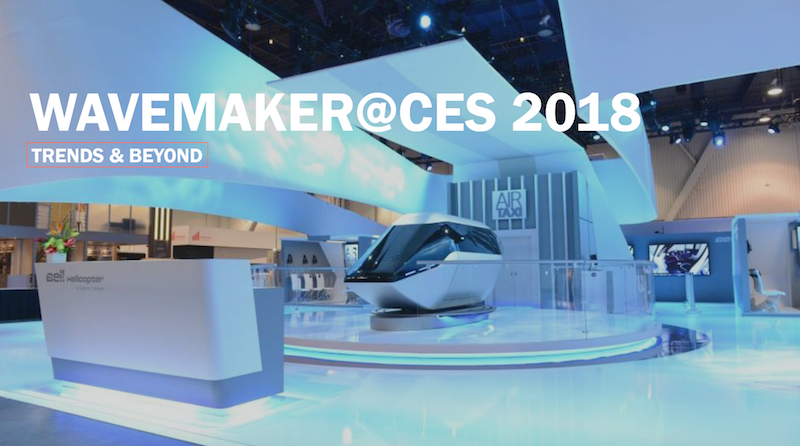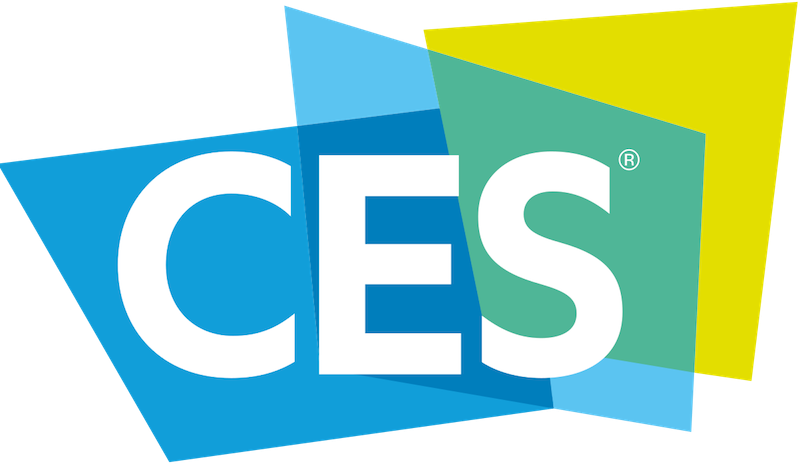The Consumer Electronics Show (CES) is usually a reliable barometer for the state of the tech industry, and this year was no exception. The sector is, without doubt, experiencing a period of rapid expansion, with digital technologies permeating almost every vertical market.
Juniper Research‘s ‘Consumer Electronics Show…what does it all mean?’ and Wavemaker‘s ‘Consumer Electronics Show 2018 – Trends and Beyond’ report together summarise the key trends and takeaways from the latest show.
The show itself has become a huge event. This was the biggest show in its 51 year history, encompassing almost every strand of digital transformation, with 2.75 million square feet of exhibition space, 300 conference streams and numerous press events and launch parties. Of particular interest this year was the expansion of Eureka Park, the platform forstart-ups, inventors and entrepreneurs. This section of the show had doubled to over 900 micro exhibitors, a very healthy sign for the sector.

Juniper Research key takeouts include:
- Development, not Disruption – Once again, there were few breakout innovations at CES 2018, with the biggest announcements coming either from the integration of technologies (primarily voice assistants into other verticals) or the incremental improvement of existing technologies and devices.
- Voice Assistants are Everywhere – CES 2018 doubled down on voice assistants. Most particularly, Alexaand Google Assistant, with the latter putting on a large display and announcing devices with partners that directly compete with the Echo Show. Alexa and Assistant are both becoming integrated into more and more devices, from cooking appliances to light switches to smoke alarms.
- Wireless Charging is Go – Following Apple’s announcement in support of the Qi standard, many more vendors showcased Qi wireless charging products. In addition to this, far-field wireless charging company Energousannounced its first wireless charging products and commercially available chipsets.
- Hybrid Computing Clams Up – Many hardware manufacturers previewed flexible laptop devices, but most of those are moving away from tablet-like detachable hybrids and instead moving to ‘clamshell’ hinged designs.
- The Robot Population Grows – The number of robots offering various services, from companionship to support in the hospitality and retail industries, grew but offered few new innovations. The biggest improvements were in navigation and interaction, both supported by AI.
- TVs Creep Forward – TVs at CES were somewhat muted, with most vendors refreshing 4Kline-ups, with only a few presenting 8K at this stage. However, many of these new devices implemented new sound capabilities, as well as a growth in the number that support voice assistants.
- Autonomous Cars Inch Closer –A variety of deals were signalled between automakers and technology firms like Intel and NVIDIA, with concept cars with timelines for release being displayed. However, there werfew new innovations for cars to be available during 2018, with infotainment system refinement being the biggest development overall.
- Specialist, Refreshed VR –Several firms showcased VR configurations for specific use cases, from VR at the gym to a VR headset paired with EEG readers for therapeutic purposes. Combined with a new untethered HTC Vive, there is refreshed excitement for the possibilities VR can offer, although not much on show at CES.

Wavemaker identified seven key trends. These are:
- Beyond the physical – CES has been all about gadgets: the tech toys that can be played with such as drones, wearables etc. This year however, what really impressed was the technology you couldn’t see; the invisible AI driven spines, 5G and biometric measurement capabilities that make tech so impressive
- 5G invisible bandwidth – with more connected technology, more devices will fight for bandwidth. To deliver seamless tech-driven experiences, marketeers will need faster response speeds than ever before. This is where 5G comes in. It won’t reach scale for some time, with networks not due to go live until 2020, but will offer bandwidth, consistency and speed
- Power of the platform: no longer about the device – Over 200 CES-shown devices touting Amazon’s intelligent assistant Alexa, signal a shift to seeing tech like it (and Apple’s Siri and Samsung’s Bixby) as more than just voice controls; these tools are voice-enabled smart-platforms, offering one core seamless platform consumers know and trust. It’s no longer about owning random devices touting the ability for users to talk to them; tech is focused on moving from individually smart to collectively intelligent by leveraging the power of larger network platforms (e.g. Amazon and Google)
- Smart home tech grows up: delivering intimacy and consistency – Now we’ve moved past singular brands trying to connect consumers on their own operating systems and moved towards brands aligning with one of these major platforms, this year we will see the battle for share of home. The desire to experiment with other smart, connected, voice activated products resulted in this years wave of enhanced AI and data-driven smart-home technology, enabling a consumer to talk to nearly ever device, from a car to a doorbell to a thermostat to even TVs.
- Autonomous vehicles: driving the future of human & brand connection – as the world gets smarter and increasingly connected, so too do transportation vehicles like cars. Autonomous cars have the ability not just to impact the in-car consumer experience, but other experiences traditionally conducted out of the car, such as retail and commerce.
- Health & wellness: from quantifying the self to caring for the self – more tech is being designed to prevent, support, treat and eradicate health issues ranging from sleep, to diabetes and cancer. These wearables signal the era of being able to not only track ongoing illness, but also stave off potential new ones via preventative tracking and treatment.
- Mixed reality: still mixed reviews but maximum potential – VR saw new headsets with a focus on standalone capabilities, removing the need for wires and cables. It’s clear that we are far from the final factor of how best to leverage AR and VR for everyday use, as well as marketing. But B2C and B2B capabilities are percolating …
To download Juniper Research’s ‘Consumer Electronics Show…what does it all mean?’, click here.
To download ‘Wavemaker Consumer Electronics Show 2018 – Trends and Beyond’, click here.














